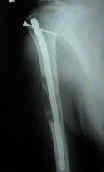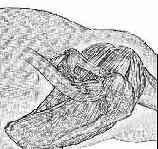
- Discussion:
- may be indicated for multi-trauma patients w/ humeral shaft frx, and patients w/ pathologic frx;
- note that following humeral shaft frx, IM nailing provides torsional and bending stiffness of only
20-30% of normal;
- indications:
- pathologic frx:
- generally non operative treatment is insufficient for these frx;
- radiation therapy is of variable benefit;
- when IM nailing is to be performed, always use a closed technique (unless open biopsy is required) so
that early post operative radiation may be started (w/ in the first week or two);
- unacceptable reduction:
- upper arm will accommodate 10-20 deg of anterior angulation & 10-30 deg of varus;
- 2 cm of frx shortening;
- Retrograde IM Nailing:
- ref: Prospective randomized comparative study of antegrade and retrograde locked nailing for middle humeral shaft fracture.
- Antegrade Nailing:
- antegrade nailing has been the traditional method of IM nailing of humeral frx and may be preferable over plate fixation for
comminuted fractures; (Chen, et al, (2002))
- anteograde nailing may be preferred to retrograde nailing for proximal shaft fracture since obtaining an exactly perfect nail length
is not manditory and because the proximal fixation is stronger;
- ref: Intramedullary nailing of humeral shaft fractures: failure analysis of a single centre series
- Nail vs Plate:
- references:
- Fixation stability of comminuted humeral shaft fractures: locked intramedullary nailing versus plate fixation.
- Management of Humeral Shaft Fractures With Intramedullary Interlocking Nail Versus Locking Compression Plate
- Randomized prospective study of humeral shaft fracture fixation: intramedullary nails versus plates.
- Treatment of humeral shaft fractures with humeral locked nail and comparison with plate fixation.
- Outcomes of Nails Versus Plates for Humeral Shaft Fractures: A Medicare Cohort Study.
- Meta-analysis of the outcomes of intramedullary nailing and plate fixation of humeral shaft fractures.
- Internal fixation of fractures of the shaft of the humerus by dynamic compression plate or intramedullary nail: A prospective study.
- Intramedullary nail versus dynamic compression plate fixation in treating humeral shaft fractures: grading the evidence through a meta-analysis.
- Randomized prospective study of humeral shaft fracture fixation: intramedullary nails versus plates.
- disadvantages:
- trumpet (funnel) shape of the humeral shaft means that the distal most canal diameter may be signficantly smaller than the
proximal canal diameter, which increases the risk of iatrogenic comminution, especially with a non reamed technique;
- nonunion
- radial nerve palsy
- rotator cuff damage:
- note that many IM nail designs do not have large diameters because this will cause a larger hole through the rotator cuff;
- note that the total length of all of the incisions (entry site, proximal, and distal interlocks) may end up being comparable to
length of the incision needed for an 8 hole plate;
- references:
- Prospective randomized comparative study of antegrade and retrograde locked nailing for middle humeral shaft fracture.
- Plating of humeral shaft fractures--has the pendulum swung back?
- Operative management of diaphyseal fractures of the humerus. Plate versus nail.
- Antegrade locked intramedullary nailing in humeral shaft fractures.
- Fixation of fractures of the shaft of the humerus by dynamic compression plate or intramedullary nail. A prospective, randomised trial.
- Complications of intramedullary nailing for fractures of the humeral shaft: a review.
- patient positioning:
- supine position, HOB raised 30-40 deg, with bump under the scapula;
- consider rotating the flouro table 180 deg, so that the head rests on the "foot" of the table;
- flouro machine should be placed on opposite side of the table, and is positioned perpendicular to the table;
- be sure that a good AP and axillary view are possible before prepping;
- protect the patient's face and eyes.
- incision:
- use deltoid spliting, rotator cuff incision;
- supraspinatus is incised in line with its fibers, just posterior to the bicipital tuberosity;
- location for entry hole:
- the location of the entry hole is subject to debate;
- linear acces to humeral IM canal is possible only thru a portal made in the sulcus between the greater tuberosity and the
articular surface (some argue that it should be posterior to the greater tuberosity);
- recognize that a more medial entry hole will enter into the rotator cuff where as a more lateral entry hole will cause some
degree of varus angulation (in proximal fractures);
- proximal third fractures may require a more medially located entry hole inorder to avoid varus angulation at fracture site;
- references:
- The anterior acromial approach for antegrade intramedullary nailing of the humeral diaphysis.
- Modified extra rotator-cuff entry point in antegrade humeral nailing.
- Antegrade humeral nailing through the rotator cuff interval: a new entry portal.
- controversies: should the fracture site be opened to ensure that the nerve is not caught between fracture ends?
- references:
- Factors affecting rates of infection and nonunion in intramedullary nailing.
- Locked nailing of spiral humeral fractures with or without radial nerve entrapment.
- Intramedullary entrapment of the radial nerve associated with humeral shaft fracture.
- reaming: (reaming for femoral shaft fractures / reaming for tibial fractures);
- is generally avoided (especially in comminuted fractures) inorder to avoid reaming-injury to the radial nerve and to avoid
injuring the rotator cuff;
- in the case of a distal funnel shaped medullary canal, hand reaming may be necessary inorder to avoid iatrogenic comminution
as the nail is passed distsally;
- references:
- Heat-induced segmental necrosis after reaming of one humeral and two tibial fractures with a narrow medullary canal.
- Segmental avascularity of the humeral diaphysis after reamed intramedullary nailing.
- Failure of reamed nailing in humeral non-union: An analysis of 26 patients.

- distal interlocking:
- nails may have either AP directed screws or medial-lateral directed screws;
- AP directed screws:
- incision is made just lateral to the biceps tendon;
- remember that the anterior cortical surface above the olecranon fossa is especially hard, and it may wise to
start the interlocking hole with a small steinman pin (before drilling) and it may be wise to tap the bone
prior to screw insertion (especially if titanium screws are used);
- lateral to medial screw insertion:
- w/ laterally directed screws, a generous 5 cm incision is made to ensure that the radial nerve will not be injured;
- references:
- Distal interlocking during intramedullary nailing of the humerus.
- Radial and axillary nerves. Anatomic considerations for humeral fixation.
- The risk of neurovascular injury with distal locking screws of humeral intramedullary nails.
- Iatrogenic nerve injury with the Russell-Taylor humeral nail.
- The risk of injury to neurovascular structures from distal locking screws of the Unreamed Humeral Nail (UHN): a cadaveric study.
- Intramedullary nailing of humeral diaphyseal fractures. Is distal locking really necessary?
- fracture reduction, compaction and final nail position:
- mallet is used to impact proximal jig assembly inorder to eliminate any fracture gap;
- goal is to eliminate the fracture gap and to have the nail counter-sunk about 5 mm below the articular surface to avoid
subacromial impingement;
- sinking nail more than 1 cm below articular surface may place proximal interlocking screws at the level of axillary nerve
(and risk nerve injury);
- if proximal end of the nail is properly countersunk, then incidence of shoulder pain may be less than 2% (Crates (1998));
- distal end of the nail should come to lie about 2 cm proximal to the olecranon fossa;
- Petsatodes et al, (2004), the authors note the need for caution for intramedullary nailing in proximal fractures (w/ osteoporosis),
avoiding nailing fracture in distraction, properly countersinking tip of the nail, and achieving adequate fixation stability
- prior to proximal interlock insertion, be sure that there is optimal frx site compression and optimal rotational alignment;
- references:
- Intramedullary nailing of humeral shaft fractures. A retrospective study of 126 cases.
- Rotational alignment of humerus after closed locked nailing.
- Antegrade interlocking nailing of humeral shaft fractures
- proximal interlocking:
- only lateral to medial placement is recommended for proximal interlocking screw;
- be sure that screws are inserted above the level of the humeral neck (so asto avoid axillary nerve injury);
- note that some humeral nail systems do not take into account that the surgeon will counter sink the nail by 1 cm which may
have the effect of the placing the proximal interlocking hole at the level of the surgical neck;
- proximal interlocking should always be performed first so as to ensure that the tip of the nail is countersunk;
- if distal interlocking is performed first, the nail may end up being pround over the humeral head or just as worse may end
up being counter-sunk more than 1 cm which risks axillary nerve injury during insertion of the proximal interlocks;
- references:
- Relationship of the axillary nerve to the proximal screws of a flexible humeral nail system: an anatomic study.
- Radial and axillary nerves. Anatomic considerations for humeral fixation.
- Anatomic considerations of locked humeral nailing.
- The risk of injury to the axillary nerve, artery, and vein from proximal locking screws of humeral intramedullary nails.
- Intramedullary fixation of proximal humerus fractures: do locking bolts endanger the axillary nerve or the ascending branch of the anterior circumflex artery? A cadaveric study.
- wound closure:
- consider rotator cuff repair, just as would be performed with a cuff tear;
- Complications:
- loss of shoulder motion:
- may occur in upto 1/3 patients w/ antegrade nailing;
- may be a consequence of violating rotator cuff at insertion site;
- even a slight prominence of IM nails caused impingement & resultant loss of shoulder motion;
- ref: The function and muscle strength recovery of shoulder after humeral diaphysis fracture following plating and intramedullary nailing.
- humeral non union:
- care must be taken not to mistake a pseudoarthrosis for a simple hypertrophic nonunion;
- treatment of the pseudoarthrosis requires complete resection of the synovial tissue, and a closed IM nail does not suffice;
- bone scan is helpful in diagnosis of pseudoarthrosis, which appears as a cold cleft between hot ends;
- if bone ends appear avascular, the bone grafting is a necessity;
- in some cases, may be treated w/ IM nailing but, non union following humeral shaft frx may also be treated w/ plating and bone
grafting rather than exchange IM nailing and bone grafting;
- in this example, a humeral shaft fracture treated w/ a Polaris IM Nail went on to non union;
Results of the use of platelet rich plasma in the treatment of delayed union of long bones.
Intramedullary fixation of humeral shaft fractures.
Intramedullary fixation of complicated fractures of the humeral shaft.
Intramedullary stabilization of humeral shaft fractures in patients with multiple trauma.
Locked nailing of humeral shaft fractures. Experience in Edinburgh over a two-year period.
A biomechanical comparison of intramedullary nailing systems for the humerus.
Treatment of humeral diaphyseal fractures with Hackethal stacked nailing: a report of 33 cases. 
Seidel intramedullary nailing of humeral diaphyseal fractures: a preliminary report.
Closed intramedullary fixation of humeral shaft fractures.
Antegrade Interlocking Nailing of Acute Humeral Shaft Fractures.
Nonunion after intramedullary nailing of humeral shaft fractures.







